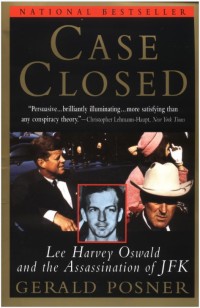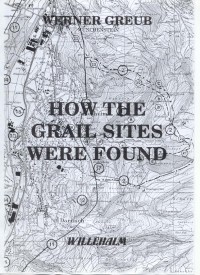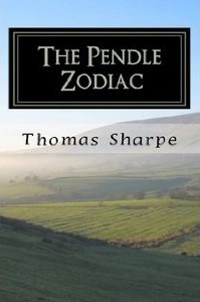Case Closed: Lee Harvey Oswald and the Assassination of JFK
By Gerald Posner
A Doubleday Anchor Book, 1994, originally published by Random House in 1993 Buy this Book!
Case Closed is a significant work in twentieth-century history that persuasively argues for the “case” of Lee Harvey Oswald (1939 – 1963) as “the lone assassin” of President John F. Kennedy (1917 – 1963) in Dallas, Texas, on Friday, November 22, 1963. Author Gerald Posner, a former Wall Street lawyer turned investigative journalist, presents a biography of Oswald that brings this troubled, dangerous, sociopathic individual to life, detailing evidence with new perspectives in a compelling way that, while not perfect, are nevertheless fuller and more convincing than the inconclusive conspiracy theories presented in Breach of Trust: How the Warren Commission Failed the Nation and Why (2005),by Gerald D. McKnight, professor emeritus of history at Hood College in Frederick, Maryland. Comments and quotations from Breach of Trust are offered in this review because the book scholastically propounds conspiracy theories while steadfastly rejecting the single assassin conclusion of the Warren Commission, a conclusion first made public in September of 1964. The truth may actually be found in-between the two sides of the argument: Oswald acted alone but was moved to actions by a complex of violent unseen spiritual forces that functioned unconsciously within him. The recognition of the roles that these very real spiritual forces play in such tragic events is long overdue and there can be no satisfactory resolutions until these realities are revealed through spiritual cognition. More on the “case” for spiritual science will come later in this review.
From the back cover of the 1994 paperback edition of Case Closed: “The most authoritative work to date… gripping and convincing… likely to stand as the starting point for any future examination of Kennedy’s death.” – The Christian Science Monitor. “Unlike many of the 2,000 other books that have been written about the Kennedy assassination, Case Closed is a resolutely sane piece of work. More importantly [it] is utterly convincing in its thesis… fascinating and important… Case closed, indeed.” – Jeffrey Toobin, Chicago Tribune. However, books and videos indicating the matter is far from settled have continued to appear since 1994, although a fair number of these accounts can only be described as parasitic. One excellent internet site (address below) that presents the most important facts and controversies about this embroiled subject with simplicity and clarity can be recommended: The Kennedy Assassination, by John McAdams, 1995 – 2012. At the bottom of the home page is a link to the Photo Gallery, and under the section “Suspects and Other Folks,” there are two photos that are especially revealing: “Oswald at Friday Evening Newscast,” where Oswald appears to be in a shock of realization, and “Jack Ruby with Defense Attorney Melvin M. Belli,” where Ruby appears to be possessed by a demon.
From Case Closed, the most important preceding event pointing to Oswald as the lone assassin was his failed attempt, on April 10, 1963, to assassinate General Edwin A. Walker (1909 – 1993), then retired and residing in Dallas. General Walker was involved in right-wing politics and white supremacy causes, which reveals him to be nearly the polar opposite of JFK. Setting out in his resolve, Oswald left a note in Russian for his wife Marina that was later discovered by the FBI. The note gives her instructions in the event that he should be arrested or should not return home. “Marina starting shaking. ‘I couldn’t understand at all what can he be arrested for,’ she recalled. She was frantic by the time Oswald returned at 11:30. He was pale and out of breath from walking quickly. ‘I showed him the note and asked him, What is the meaning of this? …And he told me not to ask him any questions,’ she said. ‘He only told me that he had shot at General Walker.’ She was horrified. She asked him about the rifle, and he said he had buried it.” Oswald was disgusted that his shot had missed, for he had planned the assassination of the “fascist” for two months. Of course, he followed the news accounts about the failed assassination, disappointed that there was nothing about it on the radio that evening, and later laughing heartily about errors in the newspaper reports. Posner adds in a footnote: “The House Select Committee utilized an advanced technique to subject the bullet [found badly damaged in Walker’s house] to neutron-activation tests, and determined the Walker slug was a Western Cartridge Company 6.5mm bullet, the same type of bullet, made by the same manufacturer, as that used later in President Kennedy’s assassination.” However, according to the McKnight book and scores of other publications, neutron-activation tests cannot provide absolute proof in these and in similar circumstances. Thus, with even the fact of Oswald’s note challenged by, e.g., Breach of Trust, it becomes necessary to rely solely on the evidence of Marina Oswald’s story. She did not initially reveal this story to the FBI, probably out of fear of incriminating herself. Later, what possible reason could she have for lying about anything like this?
Posner describes in detail the circumstances of the very dark destiny that led Oswald to the perfect time and place for the assassination, beginning with Oswald’s timely employment in mid-October with the Texas School Book Depository. The sixth floor southeast corner window of the Depository was situated just over the 120-degree turn from Houston onto Elm Street, a corner that had “an ideal, unobstructed view” of the motorcade route that had been selected earlier in the week for its convenience in enabling the Kennedys and other officials to arrive in time for a luncheon appointment. In addition, the Depository employees were also on their lunch hour, so the sixth floor was clear of witnesses to the extent that Oswald could stack up boxes so as to remain hidden and to prepare the support for his rifle. Oswald was unquestionably a “sharpshooter.” The endlessly debated question as to how many shots were fired from how many persons should have been resolved from this fact and from the ballistics evidence presented in Appendix A of Case Closed.
From the “Conclusion” of Breach of Trust: “After forty years the ‘who’ and ‘why’ of Dallas longs for an answer that cannot be given definitively and responsibly… The Warren Commission went through the motions of an investigation that was little more than an improvised exercise in public relations. The government did not want to delve into the heart of darkness of the Kennedy assassination because it feared what it might uncover: the brutal truth that Kennedy was a victim of deep divisions and visceral distrust over how to solve the “Castro problem,” and that his assassination was carried out by powerful and irrational forces within his own government.” The assassination of Robert Kennedy on June 6, 1968 has also raised many issues of possible conspiracy theories. As examples: Sirhan Sirhan was unaware of his actions and was programed by persons unknown; there was CIA involvement due to deep anger over what was seen as a betrayal by both Kennedy’s that led to the failure of the April 17, 1961 Bay of Pigs Invasion of Cuba.
Through the following quotations from Lecture One of the 1917 series of lectures on “The Fall of the Spirits of Darkness,” given by Rudolf Steiner during the chaos of World War I (all 14 lectures in this series are recommended), it can be seen that both Oswald as a lone assassin and the powerful and irrational forces unleashed due to the failure of humanity to develop spiritual cognition are responsible for the JFK tragedy. Combine these causes with the corruption and immorality rampant during this time period in multiple segments of society, including among those in the highest positions of the government, such as Lyndon B. Johnson, J. Edgar Hoover and Kennedy himself, and this leads to volatile, potentially explosive situations in human life and in society, as happened on November 22, 1963. The answer is the penetration of light, through spiritual cognition, into the “heart of darkness,” and this is not the responsibility of the government, nor is the failure to do so the fault of the government. This is the responsibility of every individual, and doubly so for political and religious leaders.
“Chaos has arisen because reality is considered in an unspiritual way and the world of the spirit cannot be ignored with impunity. You may think it is enough to live with thoughts and ideas that are wholly derived from the physical world. It is what people generally think today, though this does not make it true. The most completely and utterly wrong idea humanity has ever had is — to put it simply — that the spirits will put up with being ignored. You may consider it egotistical and selfish on their part, but the terminology is different in their world. Egotism or not, the spirits take their revenge if they are ignored here on earth. This is a law, an iron necessity. One way to characterize the present time is to say that the present human chaos is the revenge of the spirits who have been ignored for too long. I have often said, both here and elsewhere: A mysterious connection exists between human consciousness and the destructive powers of decline and fall in the universe…
“Anyone who knows the history of ideas of the last decades of the nineteenth and the first decades of the twentieth century also knows that people actually no longer knew how to use the term ‘spirit.’ It has been used to describe all kinds of things, but not the true spirit. Those souls therefore had no opportunity of knowing the spirit whilst here on earth and they have to take the consequences. Having gone through the gate of death and entered the world of the spirit, they are thirsting for — well, what are they thirsting for, these souls who lived in materialism here? They are thirsting for destructive powers in the physical world! Those are the dues and they must be paid.
“There is no easy way of dealing with these things. If we want to know the realities in this sphere, we must acquire a feeling for what the ancient Egyptians called ‘iron necessity.’ Terrible as it may be, it was necessary that destruction should spread, for those who had gone through the gate of death were longing for the destructive powers in which they are able to live, seeing they did not receive what was due to them and had been deprived of spiritual impulses while on earth.
“Just think how easy it is for some people to present their friends with an image of the region into which human beings enter when they have gone through the gate of death. Consider the unctuous sermons preached in the churches — with politicians now actually following the example of these sermonizers — and the facile notions people have of the world of the spirit, and you simply cannot help realizing how far removed from reality is the facile vanity of many of today’s leading figures. Compare the speeches of such leading figures — their lives show that they do anything but lead and that they are guided by all kinds of forces of which they are completely unconscious and which are not the right forces — compare this with what is really needed at the present time, and you will realize the immense gravity of the present situation.” – Review by Martha Keltz
References:
The Kennedy Assassination, by John McAdams, 1995 – 2012
[http://mcadams.posc.mu.edu/home.htm]
The Fall of the Spirits of Darkness, 14 Lectures by Rudolf Steiner, 1917.
[http://wn.rudolfsteinerelib.org/Lectures/GA177/English/RSP1993/19170929p01.html]




